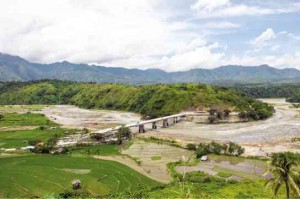
PHOTO shows the panoramic view of the 180-meter Aluling Bridge that connects the provinces of Ilocos Sur and Mt. Province. Richard Balonglong / INQUIRER NORTHERN LUZON
CERVANTES, Ilocos Sur—Francisca Aluaro, 69, was a witness to how residents of Barangay Aluling here would brave rampaging waters each time they crossed the Abra River in the 1970s.
Aluaro had also seen all modes of transport as residents crossed between this town and Tadian town in Mt. Province before the Aluling Bridge was finally constructed.
She said people first used “bangsal” or water raft to navigate the river. Then came the “galong-galong” or wooden box similar to the cable car where a road worker posted on opposite ends of the river would pull the wooden ride.
“During those days, four people could be accommodated in this wooden box and we were transported for free by government workers,” she said.
Transport further improved when officials put up a foot bridge so residents could trade products to the neighboring provinces of Benguet and La Union.
After nearly four decades and six presidents, Cervantes residents finally saw the bridge open on Thursday. It was under President Aquino’s term that the 180-meter Aluling Bridge was completed after 35 years of work since 1978 when the project was conceptualized.
The structure earned the moniker “longest bridge in the Philippines” because of the years it took for the project to be completed.
Mr. Aquino, who was originally set to open the bridge on Thursday, was represented by his sister, Viel Aquino-Dee. In a statement sent through text before the event started, Undersecretary Abigail Valte said the President was unable to attend as “he was feeling under the weather.”
Dee, accompanied by Public Works Secretary Rogelio Singson and Defense Secretary Voltaire Gazmin, instead represented the President.
In the speech read by his sister, Mr. Aquino said the long wait for Ilocanos had ended. “Sa wakas, tapos na po ang paghihintay at pagtitiis ng mga taga-Cervantes. Nalpas met laengen, Apo (It is finally finished),” he said.
Mr. Aquino said residents would “no longer dance with death each time they crossed the Abra River.”
In more than 30 years, people have been moving and trading with great difficulty even though Cervantes is only 6 kilometers away from Tadian town.
“Products, which could have been sold fresh, would turn wilted or spoiled upon reaching the other end [of the river],”
Mr. Aquino said.
He said tourists would now be encouraged to go to Cervantes and visit tourist spots such as the Gambang Falls and the Yamashita Cave.
He said the bridge took more than 30 years to finish because of neglect by those who were in power.
The Aluling Bridge was among the completed infrastructure projects that the
President presented during his State of the Nation Address last month.
Initial construction began in 1978 as a five-span reinforced concrete deck girder-type bridge that was funded on a multiyear basis by the Department of Public Works and Highways (DPWH).
In 1990, however, the bridge was damaged by floods. In 1999, the DPWH restarted work with a plan to construct the bridge on another portion of the Abra River.
The bridge was finally completed on March 25 this year.
DPWH officials said the bridge allowed faster and safer transport of people and goods between the Ilocos and the Cordillera regions.
Once the bridge is opened, more than 1,000 motorists are expected to ply the stretch with a reduced travel time of
30 minutes between Cervantes and Tadian. Before the bridge was completed, motorists used to negotiate the route in an hour.
The bridge will enable faster trading of farm, fish and quarry products for residents in downstream towns of Ilocos Sur and neighboring provinces of La Union, Benguet and Mt. Province.